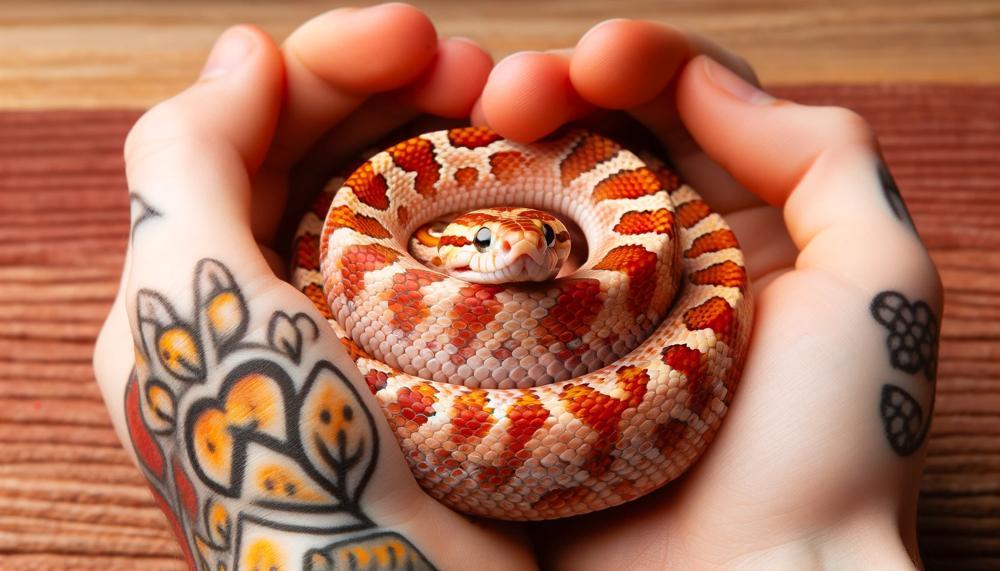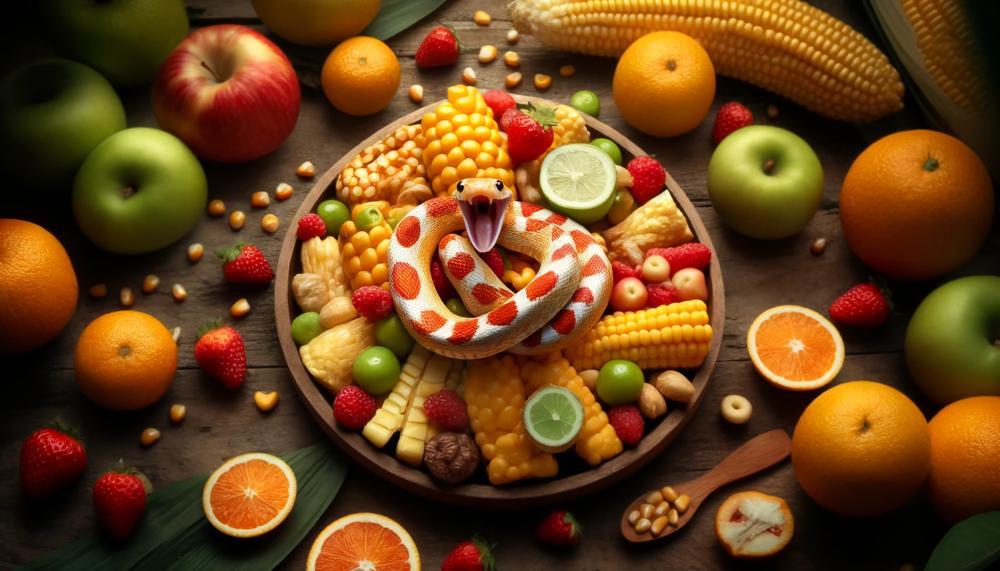Did you know that corn snakes are among the most popular pet snakes in the world?
This isn’t just because of their striking colors and patterns, which can range from sunny orange to deep, earthy reds, but also due to their relatively easy care requirements and docile nature. However, “easy” doesn’t mean “no care required.”
On the contrary, ensuring your corn snake thrives involves a specific set of care practices that any prospective or current owner should be well-versed in. In this comprehensive guide, we’re diving deep into the essentials of corn snake care.
So, what corn snakes need?
Corn snakes, also known as red rat snakes, are popular pets due to their nonvenomous nature, mild temperament, and relatively easy care requirements1. Here’s a basic guide on what corn snakes need:
- Diet: Corn snakes eat a diet primarily composed of small mammals, like mice.
- Habitat and Tank Setup: The enclosure should be large enough for the snake to move around comfortably. It should have a temperature gradient with a warm side and a cool side, and the humidity levels should be maintained properly. They also need a substrate and decor for hiding and climbing.
- Health: Regular health checks are important to prevent common health issues like Dysecdysis and Pustular dermatitis.
- Handling & Bonding: Corn snakes are generally docile and can be handled regularly, but always with care.
- Size: When newly hatched, corn snakes measure between 8 to 12 inches, while adults can reach 3 to 6 feet in length.
Contents
Corn Snake Background Information
Corn snakes are indigenous to the southeastern United States, where they flourish in a spectrum of environments. Their adaptability allows them to inhabit forests, grasslands, and agricultural areas, making them a versatile species in the wild.
The diverse habitats influence their behavior and physical adaptations, including their climbing ability and camouflage coloring.
Impact on Captivity Needs:
-
- Enclosure Requirements:
| Enclosure Aspect | Description | Justification |
| Size | Minimum 30 gallons | Mirrors the space they would explore in the wild. |
| Temperature Gradient | Ambient: 78-82°F, Basking: 90°F, Cool: 75°F | Reflects the varied thermal environments available in their natural habitat. |
| Humidity | 40-50% | Matches the moderate humidity of southeastern U.S. climates. |
| Substrate | Choices that allow burrowing and provide grip for climbing. | Simulates the forest floor and trees they would naturally climb. |
-
- Dietary Adaptations:
In the wild, corn snakes prey on small mammals such as mice and rats. This diet needs to be replicated in captivity to maintain their health and satisfy their natural hunting instincts. Feed them every 5-7 days with appropriately sized prey to mimic natural feeding intervals.
- Behavioral Considerations:
Corn snakes are primarily nocturnal and solitary. Provide hiding spots and low-light conditions to respect their natural behaviors.
Regular, gentle handling can acclimatize them to human interaction, mimicking the occasional encounters they might have with other animals in the wild.
-
- Health and Maintenance:
Regular cleaning of their enclosure and maintenance of appropriate temperature and humidity are critical.
These conditions prevent common health issues such as respiratory infections and problems with shedding, which reflect the stable environment they would experience naturally.
Corn Snake Costs
Owning a corn snake involves both initial and ongoing expenses, crucial for their care and well-being. Below is a detailed breakdown of these costs:
Initial Costs
-
- Purchase Price: Depending on the morph and source, prices can vary.
- Habitat Setup: This includes an enclosure, substrate, and essential accessories like water bowls and hide boxes.
| Item | Cost | Details |
| Corn Snake | £30 – £200 | Varies by morph and breeder. |
| Enclosure | £30 – £50 | A secure tank or terrarium. |
| Substrate | £10 | Aspen shavings or similar. |
| Accessories | £20 | Includes water bowl, hide box, and branches. |
Ongoing Costs
These are monthly expenses including food, potential veterinary visits, and incidental needs like substrate replacement.
| Item | Cost per Month | Details |
| Food | £15 – £25 | Frozen rodents are typical. |
| Substrate Replacement | £5 | Regular changes to maintain hygiene. |
| Healthcare | Variable | Includes vet visits and any treatments. |
Occasional and Unexpected Costs

These might include health check-ups or emergencies and any additional enhancements or replacements needed for the habitat.
- Veterinary Care: Regular check-ups are advisable; however, emergency visits can cost significantly more, usually ranging between £50 and £200.
- Tank Upgrades: Over time, the snake might require a larger tank or enhanced heating elements, which can add to the costs.
Cost-Saving Tips
- DIY Projects: Building your own enclosure or decorations can significantly reduce costs.
- Bulk Purchases: Buying substrate or frozen food in bulk can save money over time.
- Second-Hand Supplies: Often, items like tanks and accessories can be found second-hand at reduced prices without compromising quality.
Corn Snake Diet and Feeding Guidelines
Types of Food Required:
Corn snakes thrive on a diet primarily composed of rodents. In the wild, their diet includes mice, rats, birds, and eggs, but for captive snakes, a rodent-based diet is healthiest and easiest to manage.
Preferred Food Items:
-
- Mice – Ideally, these should be the primary food source, as they are nutritionally complete for corn snakes.
- Rats – As the snake grows, small rats can be introduced.
- Chicks – Occasionally offering chicks can provide variety.
- Amphibians and Lizards – Rarely used, mostly for variety and not a dietary staple.
Feeding Guidelines:
| Age of Snake | Prey Size | Feeding Frequency |
| Juvenile | Pinky mice (newborns) | Every 5-7 days |
| Subadult | Fuzzy mice (slightly larger) | Every 7-10 days |
| Adult | Adult mice or weaner rats | Every 10-14 days |
Key Considerations:
- Prey Size: The prey should be 1.25 times the size of the snake’s midbody to ensure a noticeable but not excessive bulge.
- Prey Type: Frozen-thawed prey is recommended over live to prevent injury to the snake and to be more humane to the prey.
- Feeding Method: Use tongs to offer the prey to avoid accidental bites during feeding.
- Health Monitoring: Regularly check that the snake is digesting its meals properly without regurgitation.
Troubleshooting Feeding Issues:
- Refusal to Eat: Occasional fasting is normal, especially in winter. Ensure the prey is warm to increase its attractiveness.
- Regurgitation: Can be a sign of stress or health issues; consult a vet if persistent.
Supplemental Tips:
- Hydration: Always provide a bowl of fresh water, as hydration aids in digestion.
- Habitat Temperature: Maintain ambient temperature to support proper digestion.
Feeding Corn Snakes: An Enjoyable Experience
Feeding your corn snake shouldn’t be a chore. With the right approach, it becomes a routine both you and your pet can easily get accustomed to. Patience and consistency in following these guidelines are key to a healthy, happy corn snake that thrives under your care.
By sticking to the outlined feeding schedule and adapting to the needs of your snake as it grows, you ensure your corn snake receives the right nutrition in the right amounts at the right times.
Corn Snake Habitat and Tank Setup
To establish a suitable habitat and tank setup for a pet corn snake, attention to detail is key. Here’s a structured guide to ensure your corn snake thrives:
Enclosure Size and Type
Corn snakes require ample space to move, climb, and explore.
A 30-gallon tank is typically adequate for an adult, providing both horizontal space for roaming and vertical space for climbing. Glass terrariums with secure mesh tops are preferred to ensure adequate ventilation while preventing escapes.
Temperature Regulation
Creating a gradient temperature within the enclosure is essential for the snake’s health.
| Zone | Temperature | Purpose |
| Ambient | 22-25°C | Main enclosure temperature |
| Basking Surface | 29-32°C | For body heat regulation |
| Cool Zone | 21-23°C | For cooling off |
Use under-tank heating pads and overhead bulbs to maintain these temperatures, and always monitor them with thermometers at different tank levels.
Humidity and Hydration
Maintain a humidity level of 40%-50% within the tank. This can be achieved through daily misting and having a water bowl large enough for the snake to soak in if desired. Regularly check humidity with a hygrometer to ensure optimal levels.
Substrate and Hiding Spots
A safe, comfortable substrate such as aspen shavings, newspaper, or reptile carpet is ideal. Avoid cedar or pine as these can be toxic to snakes. Provide multiple hiding spots at both ends of the temperature gradient to allow for thermoregulation and stress reduction. Options like hollow logs, rock caves, or commercial hide boxes work well.
Climbing Structures
Since corn snakes enjoy climbing, incorporating branches or vines will enhance their quality of life and encourage natural behavior. Ensure these structures are secure and non-toxic.
Diet Considerations
Place a dedicated feeding area within the tank to help the snake associate this spot with eating. This can reduce stress during feeding times and help maintain tank cleanliness.
Corn Snake General Health Information
Corn snakes, spirited and resilient though they are, may wrestle with certain health challenges. Being attuned to these potential ailments and their preventatives is paramount for ensuring your slithery companion flourishes.
Below is a table laying out common health conundrums corn snakes encounter, alongside strategies for keeping such troubles at bay.
| Health Issue | Signs to Watch For | Prevention Measures |
| Respiratory Infections | Wheezing, open-mouth breathing, mucus around nose and mouth, lack of appetite | Keep the enclosure clean, maintain optimal temperature and humidity, avoid overcrowding |
| Parasitic Infections | Weight loss, lethargy, decreased appetite, excessive shedding, visible parasites | Ensure cleanliness, quarantine new arrivals, regular health checks |
| Mouth Rot (Infectious Stomatitis) | Swelling, redness, discharge in the mouth, difficulty eating, drooling | Maintain sanitary conditions, monitor temperature and humidity, regular dental checks |
Meticulous care and an eye for detail can make all the difference in averting these health snags. For instance, ensure the vivarium is a haven, mimicking their natural habitat to reduce stress and bolster immunity. Be keen on the signs; swift action can prevent a molehill from becoming a mountain.
Should you spy any unusual behaviour or physical changes, it’s time for a vet visit. Remember, your diligence is the shield that guards your corn snake’s health.
Corn Snake Handling and Bonding Tips
To properly handle and bond with your corn snake, ensuring its well-being and fostering a strong relationship, follow these structured guidelines:
Initial Adjustment
- Settling In: Allow your corn snake about two weeks to adjust to its new environment before beginning to handle it. This helps reduce stress and acclimatise to its new surroundings.
Handling Frequency and Duration
- Starting Small: Begin with brief handling sessions of no more than 5 minutes, gradually extending the time as the snake becomes more accustomed to you.
- Regular but Not Excessive: Handle your corn snake at least once or twice a week, but not daily, to balance familiarity and stress.
Picking Up Your Snake
- Awakening: Ensure the snake is awake by gently tapping its body with a snake hook before handling.
- Approach Technique: Always approach your corn snake from the side to minimize defensive reactions.
During Handling
- Support and Control: Support your corn snake’s body evenly and allow it to move freely with guidance from your hands. Keep it close to your body to provide security.
- Exploration Encouraged: Allow your snake to explore and climb on you, as this builds trust and familiarity.
Times to Avoid Handling
- Post-Feeding: Do not handle your corn snake if it has eaten within the last 48 hours to avoid regurgitation.
- During Shedding: Avoid handling while the snake is shedding; their skin is sensitive and they may be more irritable.
If Bitten
- Remain Calm: If bitten, do not pull the snake away. Instead, use cold water or apply a gentle mouthwash like Listerine to encourage it to release without injury.
Understanding Signals
- Reading Body Language: Pay attention to signs of discomfort such as hissing or excessive hiding. Respect these signals by giving your snake space.
Creating a Bond
- Consistency is Key: Regular, gentle handling under the right conditions fosters trust and reduces stress in your pet snake.
| Activity | Recommendation | Reason |
| Initial Handling | Start 2 weeks post-arrival | Allows snake to settle |
| Handling Frequency | 1-2 times per week | Minimizes stress |
| Handling Duration | Begin with 5 minutes, increase gradually | Builds comfort and trust |
| Avoid Handling | Post feeding (48 hrs), During shedding | Prevents stress and physical discomfort |
Is a Corn Snake Right for You?
Corn snakes are a popular choice among reptile enthusiasts, especially for beginners.
Deciding if a corn snake is the perfect companion involves considering several factors to ensure you can meet their specific care needs and integrate them into your lifestyle.
Care Requirements
| Living Conditions | Corn snakes require a secure enclosure with adequate space. Young snakes can start in a 20-gallon tank, but adults need at least a 40-gallon tank. The habitat should include multiple hiding spots and climbing opportunities to mimic their natural environment. |
| Temperature and Humidity | Maintain a temperature gradient from 21°C (70°F) in the cool area to 29°C (85°F) in the basking area. Humidity should be consistently between 40% and 50%, which you can monitor using digital gauges. |
| Feeding | Corn snakes eat frozen-thawed prey, primarily mice, which should be offered every 7 to 10 days depending on the snake’s age and size. It’s crucial to avoid handling your snake for a couple of days post-feeding to prevent regurgitation. |
| Health Management | Regular cleaning is necessary to prevent disease. Monthly substrate changes and spot cleaning of waste are minimum requirements. Observing any changes in eating, shedding, or behavior is vital for early health issue detection. |
Lifestyle Fit
Corn snakes are generally low maintenance compared to pets like dogs or cats, but they do have specific needs that require regular attention.
They are not social animals, so they don’t need interaction to thrive, making them suitable for owners who appreciate observing more than interacting. However, regular handling is essential to keep them tame, especially when they’re young.
Long-Term Commitment
Owning a corn snake is a long-term commitment, as they can live for 10 to 30 years with proper care.
Potential owners should consider their future life circumstances and ability to care for their pet over decades.
Financial Consideration
Setting up a proper habitat can be an investment. The initial setup with a tank, heater, thermostat, hides, and substrate can cost several hundred pounds.
Ongoing costs include food, veterinary care, and energy costs for heating.
Legal and Ethical Considerations
Before acquiring a corn snake, ensure it is legal to own one in your area, and choose to adopt or purchase from reputable breeders who practice ethical breeding and care standards.
Conclusion
Taking care of a corn snake, which is a popular choice among snake lovers, is both fun and important. These bright animals, whose colors range from sunny orange to earthy red, are stunningly beautiful and easy to get along with. But their appeal goes beyond how they look; they are also pretty easy to take care of, which makes them a great pet for both experienced and new snake owners.
A good setting is needed to ensure that your corn snake does well. It needs an area that mimics the variety of environments they come from in the southeastern U.S., with temperature changes that make it feel like warm days and cooler nights, as well as surfaces that let them dig naturally. Their food, which should mostly consist of mice, should mirror how they naturally hunt to stay healthy and meet their natural urges.
Keeping their environment clean and at the right temperature and humidity level is another way to protect their health. Regular vet visits and close monitoring for signs of discomfort or sickness are also important. You can build a bond with your corn snake by treating it gently and regularly, which will make your time with this interesting animal better.
As owners take on the duty of caring for their corn snakes, they form a special bond with their animals and learn more about them.






